It’s been a busy, even crazy, week for bees around here. Between hiving packages and catching swarms, we’ve barely had a breather, and since there seems to be no way to do each event justice at this late date, here’s the recap.
Saturday: bee packages
We spent all day dispensing three-pound bee packages to guild members. Altogether we distributed about 150 packages and answered multiple questions about queen cage placement, feeding, and candy plugs. At the end of the day, Mike, the guild’s “bee package guy” offered samples of his homemade mead. Kelly is even more eager now to experiment with mead-making.
We took home two packages of bees: one Italian and one Carniolan.
Sunday: hiving the Italian bees
Saturday’s rainstorm finally broke, and we hived our Italian bees in the late afternoon at one of our new host sites. We used last year’s Kenyan top-bar hive, and added a one-gallon Ziploc bag of 1:1 sugar syrup to get the bees going. While we usually use stacks of two cinder blocks for hive stands, we added a third layer to get the hive out of reach of hungry chickens.
We spent the rest of the evening pounding frames together and adding foundation for a new 10-frame Langstroth hive for the Carniolans.. Previously we used eight-frame equipment, which makes for lighter, easier-to-work hives. We are interested, however, in experimenting with Serge Labesque’s method of beekeeping, which involves using eight frames with follower boards in a 10-frame hive body to promote air circulation.
Monday: hiving a swarm and the Carniolans
After picking up a 25-pound bag of laying crumble and chick scratch for the practically grown-up chicks, Kelly received a phone call from a beekeeping friend who had two swarms: one huge one, about 20 feet up in a magnolia tree, and one small one about two feet off the ground. The large swarm went to a longtime beekeeper who experienced major losses over the winter, and we got the small one.
We raced to gather half the equipment we had prepared for our package, and set up a new hive at a second host site for the small swarm. Unlike our multi-queen swarms, this group of bees seemed extremely well organized and competent. As soon as we dumped them in the hive, they came out the entrance, fanning their pheromones in the air to let stragglers know that the queen was inside.
Back at home, we hobbled together enough equipment for the Carniolans and set off to hive them at a third host site. After spending six days in a wood and mesh box with a can of corn syrup for sustenance, a number of the bees had died, but the group seemed thrilled overall to be released.
Tuesday: feeding bees
Sarah made the rounds to all three host sites, and checked and refilled sugar syrup. All told, the trip took about two hours.
Thursday: the queens are released and we take a break
We checked the queen cages and found that both package hives had chewed through their candy plugs and released the queens. This is good news. The mated queens can now start laying eggs.
We abandoned making frames in the evening in favor of washing dishes and collapsing. Our top-bar had already swarmed, so there was no reason to be prepared for anything. Right?
Friday: another swarm and virgin queen piping
We came home from a long day of work to discover (quite by accident) a swarm in our orange tree. The bees were only about five feet off the ground. We stopped making dinner and hastily modified a top-bar hive that we deemed too deep by using a jigsaw to cut it in half.
As dusk approached, we suited up and Kelly skillfully pruned off two small branches from which the bees were hanging. While Sarah stood at the ready to put top-bars in place, Kelly slowly walked through the garden holding a dangling swarm. She shook the bees gently into the hive and we replaced the top-bars.
Had our top-bar hive, Mondo, swarmed again? We weren’t sure. Lying with our heads under Mondo, we looked up with a flashlight and watched bees tending a queen. The hive appeared much emptier than it had, and the bees seemed agitated. As we watched, the queen darted out of sight between two combs, but minutes later we spotted another queen alone on the back wall of the hive. She began piping. The noise is strange and distinctive. It sounds like a high-pitched, bleating buzz. From our understanding, this is a behavior exhibited by virgin queens to call out other virgins to fight. The piping continued for 10-15 minutes before we went back inside to fix dinner and make frames.
Saturday: re-hiving the swarm and yet another swarm
During breakfast, we noticed a handful of bees with their butts protruding from the entrance of the new top-bar hive. We saw little in the way of orienting flights, which we would expect to see from a new hive just getting their bearings.
As the morning progressed, the bee butts grew more numerous and we became anxious that the colony was preparing to swarm again. We hastened to anchor foundation wax in the frames we had built, and Kelly abandoned painting hive equipment.
We suited up and took a look inside the new top-bar. We saw a total of five different clusters of bees, with the largest spilling out the entrance. Presumably, each cluster surrounded one queen. To prevent the larger, more vigorous group from getting away, we dumped the whole box of bees into the Langstroth hive we had prepared.
We theorized that this would at least slow down the swarm which was beginning, that the bees might be more apt to stay put when they found themselves in a hive that already contained wax, and that the smaller space might force the multiple queens to finally duke it out. It appears we were correct.
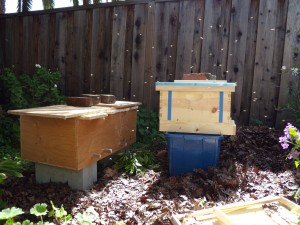
In the aftermath of the hive transfer, there was a cloud of bees trying to figure out where they belonged.
But while we congratulated ourselves on our quick thinking, Mondo was on the move again. At lunchtime, we noticed large numbers of drones at Mondo’s entrances. As we pounded away feverishly on our still unfinished chicken coop after lunch, we heard a loud buzzing. Sarah went to investigate, and spotted yet another swarm high in the camphor tree. We are almost sure that it came from Mondo. In a matter of minutes it dispersed, moving as a cloud over the neighbors’ house, dipping toward their wisteria, then through the liquidambars and across the street. It finally settled again about 30 feet up in a huge tree.
Like any mothers, we feel glad and proud that they are in the world, and we worry for their safety.

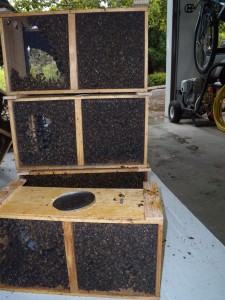
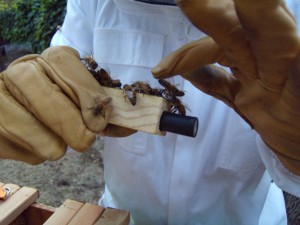
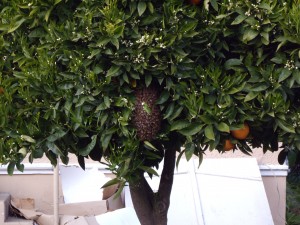
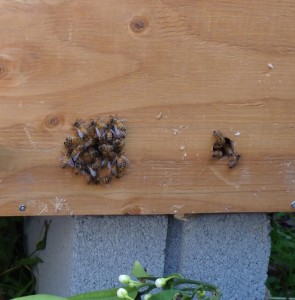

4 Responses to Beekeeping Marathon